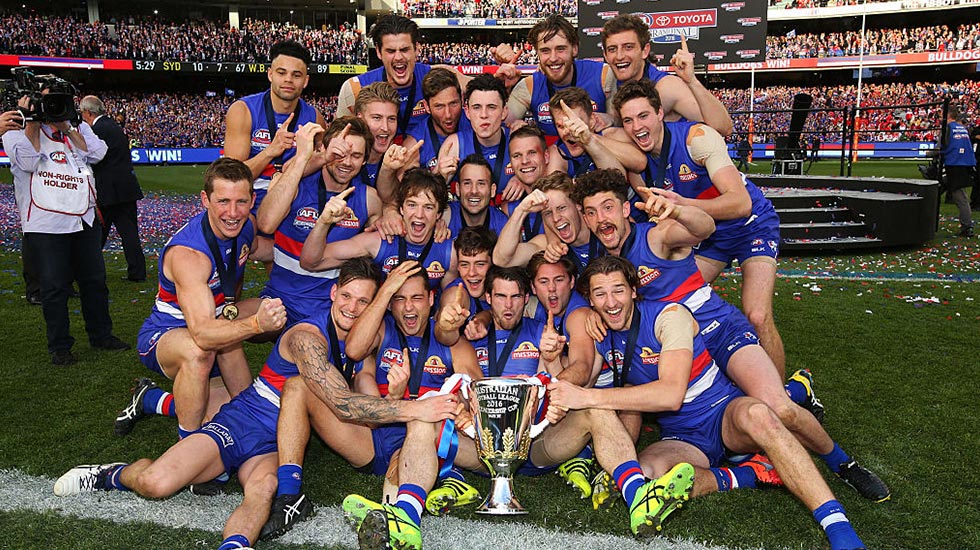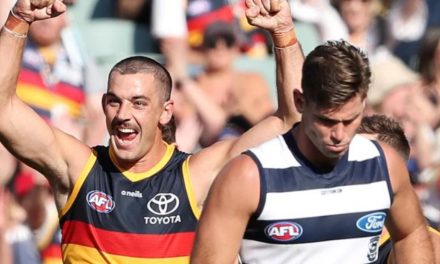The romance of the Western Bulldogs’ flag triumph distracted from what might be a considerable elephant in the room this finals series. Photo: GETTY IMAGES
Pre-finals bye the elephant in the AFL’s room
Last year’s AFL premiership was a story good enough to melt a football romantic’s heart. It was good enough also to overshadow what might have been a considerably-sized elephant in the room.
It’s another reason the people at AFL headquarters might be barracking hard for a Melbourne or St Kilda flag come the business end of the season a couple of months from now.
Because in 2017, if there’s no equivalent romance to the Western Bulldogs of last year, that elephant might well end up stomping all over something precious but too often overlooked, the integrity of the entire competition.
The ramifications of last year’s pre-finals weren’t exactly ignored, but they did get lost in the wash more than a little as the football world rejoiced in the Bulldogs reaching their first grand final for 55 years and winning their first flag for 62.
They played the best football when it mattered most. But something about the way the 2016 premiership was won still nags at me. And it’s the fact that, but for the bye, the Dogs would more than likely have been eliminated in week one of September.
They’d finished seventh on the ladder, albeit an impressive seventh with a record 15 wins. But what about had their elimination final against West Coast been played a week earlier, as it would have been in any other year?
It’s almost certain they would have been without four key players – Jack Macrae, Tom Liberatore, Easton Wood and Jordan Roughead – all of whom were able to get to the line against the Eagles with the benefits of an extra week off. Even the most one-eyed Dogs fans would concede their absence would have made an enormous difference to the result.
In that regard, the Bulldogs got lucky. They might also have been fortunate to go into a grand final against a side they’d beaten the past couple of times they’d met, and not the one (Geelong) which had beaten them 10 times in a row. And there’s evidence to suggest that had a bit to do with the bye as well.
Prior to last season, of the previous 18 preliminary finals, just one (Hawthorn in 2015) had been won by a team which hadn’t also won the qualifying final, had a week off, then took on a more-fatigued opponent.
Last year, both qualifying final winners were rolled, Geelong and GWS having by then, thanks to the pre-finals bye, played only one game in 27 and 28 days respectively, after for five months having played week in, week out.
Their price for winning their first finals was to lose momentum at the most critical part of the season, a major and most unwelcome break from routine. It cost Geelong, particularly, big time, the Cats jumped at the start of their preliminary final against Sydney conceding seven goals to nothing, the contest effectively over by quarter-time.
The Swans ended up grateful for having lost their qualifying final to the Giants, several of their players privately having expressed concerns about how they’d fare in the first final after the pre-finals bye, and relieved to at least have had a couple of consecutive games before they took on the Cats.
In the finish, slow out of the blocks with just one game in a month under their belts, Geelong’s record of eight straight wins going into the preliminary final, the best record of any of the four preliminary finalists, counted for zero. It shouldn’t have.
Top-four teams work for 22 games to acquire the chance to move straight into a preliminary final plus gain an edge over more-fatigued rivals by having a week off when their opponents don’t.
Not only has the post-round 23 bye removed that advantage, it has left the winners of the two qualifying finals at a distinct disadvantage come preliminary final weekend, having played just one game over a four-week period.
Sure, the Bulldogs became the first team under the current final eight system to win the flag from outside the top four, but was any predecessor’s failure to do so a bad thing? Isn’t getting that top-four advantage the very reason teams are busting a gut through 22 games between March and August?
And did the bottom half of the eight need the extra help anyway? Particularly given three of them (Adelaide, West Coast and the Dogs) had managed to win 15 or 16 games.
Indeed, recent history suggested that the capacities and quality of the top and bottom halves of the final eight had tightened considerably.
In 14 seasons of the current final eight system from 2000-13, just two of 56 preliminary finalists had got there from the bottom half of the eight. But even before last year, in the previous two seasons another three teams managed it. In 2015, Hawthorn was the first team in nearly a decade to win a premiership playing every week of a finals campaign.
Surely in 2017, a season universally acknowledged as the tightest of all time, those finishing between fifth and eighth are going to be even more capable of going all the way without an extra leg-up. And if they’re not? Well, they should have won more games to finish top four.
The best team of the season doesn’t always end up winning the premiership. But our current finals system has been consistent indeed in rewarding with significant advantages the sides that earned them over 23 rounds of hard slog.
Isn’t that the way it should be? But what’s the point in earning those rights when actually doing so then winning your first final effectively puts you at a disadvantage? To me, it’s a major compromise of the whole point of the home and away season, something that the finals should reflect, not come as some sort of post-season lucky dip.
You’re not hearing much about it now. But you can bet your life you will if those two qualifying final winners-turned preliminary final losers from last year becomes four from four this September.
Don’t say you haven’t been warned. And don’t tell me then that the integrity of the premiership hasn’t been devalued by a thoughtless stroke of an AFL pen.












As much as I hate to admit it everything you said is correct . Being a Dog man I was surprised and delighted at the way the cards fell our way . We played out of our skins for a month . Having said that , what is your take on the bye now ? Two top four sides made it . Was it better player management or a weaker bottom of the 8 . Cheers
Biggest issue with fairness in the AFL is the uneven draw not the pre finals bye. How can we honestly say the top four deserve the “advantage” they get when the draw is different for every team throughout the season. The issue of one game in 27 or 28 days is questionable. Their opponents only played 2 games in that time – is that an advantage versus the extra rest. In the days of the final 5 the top team would also only play once in 27 or 28 days if they won their first final before meeting a team that had played the previous 3 weeks. That was seen as an advantage.
Was not one of the benefits of the bye to get the best players playing – so it met that purpose for the Bulldogs at least.
“The Swans ended up grateful for having lost their qualifying final to the Giants, several of their players privately having expressed concerns about how they’d fare in the first final after the pre-finals bye..” yet it did not seem to bother the dogs at all…..can’t argue it both ways.
Your other arguments are mainly about Geelong
I think Bulldogs not meeting the Cats had most to do with Isaac Smiths last shot at goal rather than the bye. But rather than Dogs being lucky not to play Geelong, were Sydney lucky to play Geelong who they had beaten at Geelong during the season too – incidentally also after Geelong had the bye.
As for the momentum argument and Geelong being slow out of the blocks …..what about GWS they were 14 points in front in the last quarter of the prelim, had momentum and should have had the energy to run over the dogs……
“Top-four teams work for 22 games to acquire the chance to move straight into a preliminary final plus gain an edge over more-fatigued rivals by having a week off when their opponents don’t…. “ importantly top four also gives you a second chance if you lose your first final. Sydney earned that finishing top of the ladder no real surprise then they beat Geelong.
Geelong also tend to lose after byes at least over the last three years.
In fact is that the real elephant….Geelong’s inability to win after a bye which might suggest they have an issue in how they are trained/coached/managed to deal with it.
As a Bulldogs supporter I am sick and tired of people trying to tarnish the Doggies premiership be it the bye or the umpiring or whatever. They played the best football of the final series and deserved to win it in September/October. Where they the best team all year – it does not matter they were the best team when it counted. Did the bye help – probably – but if the other teams could not use it to their advantage then whose fault is that.
If the winner is not from the top 4 in 2017, then we have to admit we have a serious problem. I loved that the Doggies won last year, the bye suited them because of the players out short term through injury and they absolutely made hay and deserved to. Their performance in Perth against the WC (what a deserved name) and against GWS in a corker of a game showed they could play when it mattered. And they lost so many games last year by very small margins so their finish of 7th was not a true reflection of their performance. Having said all that…the pre-finals bye is seriously wrong. The momentum drops away, the lost weekend is horrible and the teams in the top four could potentially play one game in 3 weeks before the prelims.
And worse – it was a change for no reason other than to prevent the “tank” in the last game of the season. So what? So coaches protect star players? Big deal! There is still enough action to make the last round fun for footy fans, and anyway if teams do take it easy then they take it easy for two weeks with the bye.
Bye bye, bye.
Teams weren’t ready for the extra bye last year , they won’t let it happen again.
The flag winner will come from the top four this season 🙂
If the bye was so precious, it was surely the Western Bulldogs who got the rough end of the stick.
Not only did they play on the Sunday in round 23, they played on the Thursday night in week one of the finals.
In between, they had to fly home from Perth after round 23, then fly back to Perth.
Why was it such a crime for the Bulldogs to get four injured players back into the team?
Should they not have been commended for reaching the finals without those injured star players?
If the likes of Macrae, Liberatore, Wood, Johannisen etc were playing the whole season, they would’ve made the top four.
How about the injuries the Bulldogs sustained during the finals? No mention of those?
Look at this season, what would you say if Patrick Dangerfield got injured for Geelong, say a hammy three weeks out from the finals, and the week off helps him recover?
Do we not want the best players playing in the finals??
The week off is brilliant because it gives most players a chance to rest up and go again.
The injured players get a week extra to make their comeback.
If I remember correctly, the first week of the 2016 finals was a ripper, and 2017 will be no different, nor will 2018, 2019 …
Yes, the bye changed the dynamic of the finals a bit. It may well do it again at some point (then again it may equally help a top-four side who are suffering injuries).
I don’t get the criticism. Stuff changes. Let it. Adapt. Get a grip.
I do admit it left the weekend feeling a bit of a waste – there needs to be something to replace it. Maybe just something involving the 10 who missed out. Round-robin for points to go into the draft draw maybe?
Let’s not forget all of us having to do all the household chores during the bye that we’d promised the missus we’d take care of after the season and having that empty feeling inside all weekend as for some reason they stopped the footy at the most exciting time of year :////
Anyone who’s watched the replays of the Bulldogs games through the second half of last season, and especially the finals, would know that it was an extremely lopsided free-kick count, which was nothing short of laughable. And then there’s the free-kicks that were missed… just ask Tom Scully and Dan Hanneberry!
Rohan, thanx, glad I’m not the only one to rail against the pre-finals bye.
Fair analysis Rohan, But we still had to beat four teams that finished above us, all sudden death and two of them interstate, in consecutive weeks.
With all these genius coaches, psychs and analysts around, why didn’t Geelong and GWS foresee the problem and arrange a practice match for
their weekend off? If they wanted a fair dinkum hit out, they could’ve played each other. So what if they risked a hammy or two, we had to.
And good onya. Love the look of the site.
Or could the other possibility be that the team that was only two games out of top spot just played better than their rivals in the finals. Your argument that the Dogs were lucky getting 6 important players back due to the bye can be looked at alternatively by saying they were extremely unlucky to be missing all 6 in the first place. If the Hawks had been missing of their top 10 the previous year perhaps the would not have won.
I agree that the finals system should work in favour of the most consistent teams over 22 rounds. But, that said, why have eight out of 18 qualify? The NFL playoffs are another “anyone can win” crapshoot and even they have a smaller proportion of teams involved.
Personally, I object to the pre-finals bye as a fan momentum-killer more than anything else.
The bye is a reasonably sized elephant, but I will give you a giant one. The GF is always played in Melbourne! It is rarely mentioned because most footy journo’s are Melbourne based and support Melbourne teams who the rule advantages and many Melbourne based supporters still consider the AFL to be the VFL plus a few ring ins. Also that old one about “tradition” is brought up, but that is just a rubbish excuse. I realise the MCG has a long term deal, but the minute that deal finishes it should be changed to have the GF rotating to different cities (home team wouldn’t work in the short term).
As the person who devised the Final 8 system currently used by both the AFL and NRL I totally agree with this article. The pre-season bye compromises the integrity of the finals and must go! It took the AFL six years to accept my system was better than Ken McIntyres Final 8, I wonder how long it will take them to realise the stupidity of the pre-season bye?
Interesting Rohan. Only been 1 year so far. If seeds 1 & 2 win their QF and PF this year do you stay with the notion raised in this piece? I think we have to give it a few more years. I actually find the pre-finals bye so boring when the season should be nearing a crescendo. I’m sure the players appreciate it though. Is that 9’s exhibition thing still happening in the bye this year? Can you tell me why Rd.23 has not been scheduled yet? Is it critical when the minimum break for a finals team is going to be 11 days (ie. Sunday to Thursday week)? Are they really worried if an 11 day break team plays a 13 day break team? Confuses me anyway. Keep up the good work. Site looks great.
Rohan, congrats on your website. Really, really looking forward to being able to read and comment on your wise words.
As a Geelong fan, it’s obviously difficult for me to disagree with you on the topic. It will indeed be very interesting to see what happens this year. Geelong in particular, have a poor record after the bye, so are a team who like to keep playing to keep the momentum up.
For that reason, I’m not overly fussed if we end up fifth or sixth this year. I’d actually prefer that to an ‘away’ game against Adelaide, Port or GWS.
Then again, if we do end up with an away game to any of those, and lose, we get to play the next week, so hopefully either way will be to Geelong’s advantage.
Couldn’t agree more Rohan. Last year finishing top 4 meant very little.
Agree completely with these sentiments, Rohan. The Bulldogs publicly stated they had benefited from the bye last year, not only regaining key players, but several who were much fresher than their opponents in every final they played. On GF day they benefited from poor selection by the Swans, who picked several badly underdone players, early injuries to key opponents, the loss of a significant opposition midfielder at the start of the last quarter and umpiring so bad, even the AFL decried it as substandard. Crucial missed umpiring calls also benefited them in the Prelim, although I also think this was the best final they played. West Coast in the Elimination Final were still reeling from the loss of Naitanui. The “footy Gods” certainly did smile on the Dogs last year, but I suspect there will be howls of outrage if a team like Port or Sydney benefited in similar fashion this year.
I wonder into the future if it will be called the Brad Scott Memorial Bye (although it is forgotten Ross Lyon did it as well). IT was very strange, a weekend with no footy after the hype of the home and away and the finals. It was a classic AFL linear knee jerk reaction (Shot clock is another one). THe reaction was also about clubs playing a second string team, not about the advantage it might have brought. eg Coach rests players. We don’t like that. Lets rest everyone. In that instance it was only because there was nothing riding on the game, which is reasonably rare in modern footy. I think that year the eight was settled pretty early on. And, as a North supporter, it was a pretty entertaining game, having a more experienced Richmond on toast for over a half.
I think the league just need to be more forceful with penalties for clubs or coaches found to be “managing” players. IF players are rested/managed, they have to be medically examined. By an independent specialist (in the same way this happens with workcover or TAC)
Thank you for the article Rohan, and no doubt the bye before the finals did assist the Doggies to get back 4 good players, however, the club had a very good H&A season, which no one ever mentions. If you look at the whole 2016 season, there was only one loss (against Geelong) where we were never in the game. All the other losses were close and we could have won the lot. The season was riddled with injuries, but we kept on bringing in another soldier and virtually used up the whole list.
Forgetting the bye round, the Doggies actually had a tough finals series having to travel to Perth, then taking on the previous premiers, then travelling to Sydney before the Grand Final. I am not sure any other team could have done what we did from 7th. Don’t forget, we weren’t an ordinary 7th with only a couple of games separating the top 7. That hasn’t happened in a very long time.
I do agree, the teams that only played 1 game in 28 days is not ideal and the AFL maybe needs a re-think on what to do in the future.
We will never know what the outcome would have been if that bye wasn’t availabe.
Don’t disagree RoCo. I once heard Dermie say that to win a Premiership you have to have a lot go right during the season, but you also have to have a lot go right during September.
No doubt the bye helped us get players back that wouldn’t have been right a week beforehand, the following week we played the Hawks, who but for a missed kick after the siren would have had the week off & pitted us against our bogey team Geelong.
Steve J gets rubbed out for striking Kennedy & misses the Prelim, the sort of big game he gets up for. Again, avoid Geelong in the Grand Final. The planets just aligned.
Yes, we had a little bit of luck go our way, be gee we played bloody good footy & made this 52 year old Bulldogs supporter’s dream come true!
I agree RoCo the bye is a momentum killer, the AFL can’t stop themselves from tinkering with the game.